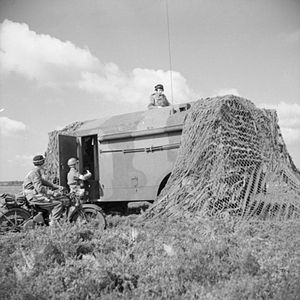AEC armoured command vehicle
This article includes a list of references, related reading, or external links, but its sources remain unclear because it lacks inline citations. (April 2009) |
| AEC 4x4 ACV | |
|---|---|
 A well camouflaged command post. | |
| Type | Armoured command vehicle |
| Place of origin | United Kingdom |
| Service history | |
| Used by | British Army |
| Wars | World War II |
| Production history | |
| Produced | 1941 - ? |
| No. built | 415 |
| Variants | Low Power, High Power, AEC 6x6 ACV |
| Specifications | |
| Mass | 12.2 t |
| Length | 6.10 m |
| Width | 2.36 m |
| Height | 2.90 m |
| Crew | 7-8 |
| Armour | 10-12 mm |
Main armament | 1 x .303 inch Bren light machine gun, carried inside |
| Engine | AEC 187 6-cylinder diesel engine 95 hp (71 kW) |
| Power/weight | 7.8 hp/tonne |
| Suspension | wheeled 4x4 |
Operational range | 450 km |
| Maximum speed | 60 km/h |
AEC Armoured Command Vehicle was a series of command vehicles built by the British Associated Equipment Company during World War II .
History

During World War II the United Kingdom was the only country to develop and widely employ purpose-built armoured command vehicles. Those were essentially armoured buses based on truck chassis.
The most common ACV of the British Army was the AEC 4x4 ACV. The vehicle, based on AEC Matador chassis, entered production in 1941. A total of about 415 units were built. The vehicle was used for the first time in the North African Campaign and remained in service until the end of the war. Big and comfortable, it was nicknamed Dorchester by the troops, after the luxury hotel in London. Three ACVs of this type were captured by the German Afrika Korps. Two of them, named "Max" and "Moritz", were employed by Rommel and his staff throughout the campaign.
In 1944 a larger AEC 6x6 ACV was developed. The vehicle was based on AEC 0857 lorry chassis and was powered by the AEC 198 150 hp engine. The hull was welded from 9 mm thick rolled steel. The weight of the vehicle reached 17 tons. One hundred and fifty one units were built.
Both vehicles were built in two configurations, called LP (Low Power) and HP (High Power), with different radio equipment.

See also
Notes
References
- Forty, George - World War Two Armoured Fighting Vehicles and Self-Propelled Artillery, Osprey Publishing 1996, ISBN 1-85532-582-9.
- Moschanskiy, I - Armored vehicles of the Great Britain 1939–1945 part 2, Modelist-Konstruktor, Bronekollektsiya 1999-02 (И. Мощанский - Бронетанковая техника Великобритании 1939–1945 часть 2, Моделист-Конструктор, Бронеколлекция 1999-02).
